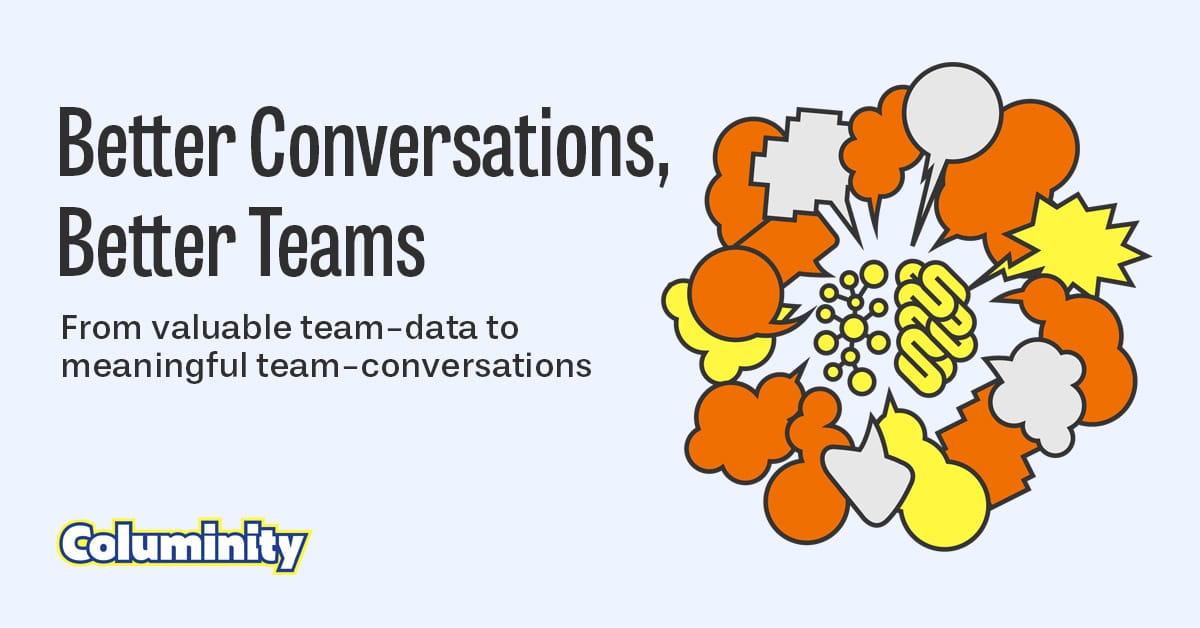Better Conversations, Better Teams
Numbers tell only part of the story; the real breakthroughs happen in the conversations around them.

The purpose of Columinity is to improve teams and organizations through conversations based on data and scientific insights. Ironically, those very conversations are often the hardest for teams to have. They touch on sensitive topics, require vulnerability, and can easily drift into surface-level chatter if not handled with care.
Too often, the focus stays on the numbers or on ticking off the standard retrospective flow (start/stop/change), rather than on the deeper dialogue that leads to lasting, systemic change. Data alone doesn’t create improvement; it’s the human side of the conversation that turns insights into action.
That’s where Columinity’s (multi-)team reports come in: they don’t just present numbers, they spark dialogue. To make the most of that opportunity, here are a few practical tips to guide those conversations:
1. Give it enough time
Reviewing the team report in a Retrospective is a great idea, but if your retros are usually 30 minutes, it’s not enough. A meaningful conversation can easily take two hours, but if it helps solve issues the team has struggled with for months, it’s worth it. Go for depth, not speed. Block the time upfront and protect it; context switching kills depth. If two hours is unrealistic, split it into a 75-minute deep dive and a 30-minute follow-up; momentum beats squeezing it in. Use the last 10 minutes to capture decisions and owners so insights don’t evaporate.
Next up: once you’ve created the time, make sure the right people are part of it.
2. Talk "with", not "about"
Bring in the people who influence your team’s results. Leaving them out risks the conversation sliding into speculation or gossip, which feeds a toxic culture instead of solving problems. When those voices are present, the team can replace assumptions with real insights and co-create better solutions. It also builds mutual respect; issues feel less like finger-pointing and more like shared challenges.
Once the right people are in the room, the next step is to learn how to have a productive conversation together.

3. Practice having a conversation
Good conversations don’t just happen; they need practice, structure, and time. The more you practice, the better you get at listening, asking thoughtful questions, and building on ideas. Liberating Structures, such as Conversation Café, make this easier. Think of it as training a muscle; the more often teams do it, the more natural it feels to stay open, curious, and respectful. Even small rituals, like a quick check-in round, can strengthen the team’s ability to connect and engage meaningfully.
Of course, good conversations aren’t just about talking, they’re also about resisting the urge to jump to easy answers too soon.
4. Don’t rush to quick fixes
A low score can make it tempting to act immediately, but fast fixes often address symptoms, not causes. Sometimes the most critical step is to slow down, understand the problem, and then decide what to do. Teams that pause to explore patterns and root causes often discover that what seemed like a “people issue” is actually a structural or systemic one. By resisting the urge to patch things up, you give space for deeper insights and more sustainable improvements.
And once you’ve decided to go deeper, the way you facilitate that process becomes just as important as the content of the discussion.
5. Don’t facilitate on autopilot
Simply moving through the agenda can block the team from discussing what matters most. Stay alert and be ready to adapt; flexibility often leads to better conversations. A good facilitator balances structure with responsiveness, knowing when to pause, when to probe, and when to let silence do its work. The goal isn’t to “get through” the meeting, it’s to create space where authentic dialogue can happen.
That space is only valuable, though, if people step into it with curiosity and openness.

6. Be curious, stay open
Encourage everyone to go in to learn, not to confirm what you already believe. Curiosity opens the door to honesty and different perspectives. An open mind creates space for honest dialogue. It also lowers defensiveness; people feel safer to share what’s really going on when they sense others are listening to understand, not to argue. Sometimes the most valuable insights come from the least expected corners of the room.
And while curiosity drives the conversation forward, it’s equally important not to let the numbers pull it off track.
7. Don’t let the numbers take over
Discussions can easily get stuck in debating scores. The data is just the starting point. Avoid “analysis paralysis” and focus on the stories and experiences behind it. A number can signal where to look, but it can’t explain why things are the way they are. Real change comes from exploring the human experiences that sit beneath the data; the frustrations, successes, and daily realities that numbers alone can’t capture.
And once teams start sharing those stories, it’s worth paying attention to how they actually talk with each other in the room.

8. Consider changing the way the team talks
Teams often bring their habits into workshops: rushing to action, avoiding sensitive topics, or talking in circles. Use this moment to slow the pace, create space for vulnerability, and encourage empathy. A simple shift, like letting everyone speak without interruption, can transform the quality of the dialogue. When teams experience a different rhythm of conversation, they often realize that new insights emerge and old patterns can finally be broken.
To make this work, though, clarity about your role as facilitator is essential.
9. Be clear about your facilitator hat
If you want to join as a participant, say so, and make it clear when you’re back in facilitation mode. This keeps boundaries clear and ensures the team owns the conversation. Blurring the line can confuse people, as it is unclear whether you are guiding or contributing, which risks undermining trust. By being transparent, you strengthen both your credibility and the team’s sense of ownership.
Because in the end, a team report is never the final word; it’s just the spark that starts the real conversation.
Closing thoughts
A team report is the start of a conversation. The listening, the questions, the curiosity, and the moments of honesty are where the breakthroughs happen. Give teams the time and space to talk openly, and let the data become a trigger for improvement! When teams treat the report as an invitation rather than a verdict, it becomes a catalyst for deeper understanding and real change. Over time, these conversations don’t just solve problems; they strengthen trust, resilience, and the team’s ability to grow together.
If your team or organization wants support in turning data into conversations that make a difference, we’d be glad to help. Feel free to reach out; we’d love to explore what’s possible together.


